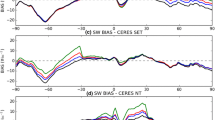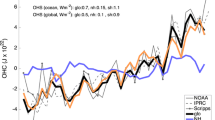Abstract
We investigate the possible causes for inter-model spread in tropical zonal-mean precipitation pattern, which is divided into hemispherically symmetric and anti-symmetric modes via empirical orthogonal function analysis. The symmetric pattern characterizes the leading mode and is tightly related to the seasonal amplitude of maximum precipitation position. The energetic constraints link the symmetric pattern to the seasonal amplitude in cross-equatorial atmospheric energy transport \( {\text{AET}}_{0} \) and the annual-mean equatorial net energy input \( {\text{NEI}}_{0} \). Decomposition of \( {\text{AET}}_{0} \) into the energetics variables indicates that the inter-model spread in symmetric precipitation pattern is correlated with the inter-model spread in clear-sky atmospheric shortwave absorption, which most likely arises due to differences in radiative transfer parameterizations rather than water vapor patterns. Among the components that consist \( {\text{NEI}}_{0} \), the inter-model spread in symmetric precipitation pattern is mostly associated with the inter-model spread in net surface energy flux in the equatorial region, which is modulated by the strength of cooling by equatorial upwelling. Our results provide clues to understand the mechanism of tropical precipitation bias, thereby providing guidance for model improvements.






Similar content being viewed by others
References
Adam O, Bischoff T, Schneider T (2016a) Seasonal and interannual variations of the energy flux equator and ITCZ. Part I: zonally averaged ITCZ position. J Clim 29:3219–3230. https://doi.org/10.1175/JCLI-D-12-00467.1
Adam O, Schneider T, Brient F, Bischoff T (2016b) Relation of the double-ITCZ bias to the atmospheric energy budget in climate models. Geophys Res Lett 43:7670–7677. https://doi.org/10.1002/2016GL069465
Adam O, Schneider T, Brient F (2017) Regional and seasonal variations of the double-ITCZ bias in CMIP5 models. Clim Dynam. https://doi.org/10.1007/s00382-017-3909-1
Adler RF et al (2003) The version-2 global precipitation climatology project (GPCP) monthly precipitation analysis (1979-present). J Hydrometeorol 4:1147–1167. https://doi.org/10.1175/1525-7541(2003)004%3c1147:TVGPCP%3e2.0.CO;2
Bellucci A, Gualdi S, Navarra A (2010) The double-ITCZ syndrome in coupled general circulation models: the role of large-scale vertical circulation regimes. J Clim 23:1127–1145. https://doi.org/10.1175/2009JCLI3002.1
Boccaletti G, Pacanowski RC, Philander SGH, Fedorov AV (2004) The thermal structure of the upper ocean. J Phys Oceanogr 34:888–902. https://doi.org/10.1175/1520-0485(2004)034%3c0888:Ttsotu%3e2.0.Co;2
Broccoli AJ, Dahl KA, Stouffer RJ (2006) Response of the ITCZ to Northern Hemisphere cooling. Geophys Res Lett. https://doi.org/10.1029/2005GL024546
Collins WD, Lee-Taylor JM, Edwards DP, Francis GL (2006) Effects of increased near-infrared absorption by water vapor on the climate system. J Geophys Res-Atmos. https://doi.org/10.1029/2005JD006796
De Szoeke SP, Xie SP (2008) The tropical eastern Pacific seasonal cycle: assessment of errors and mechanisms in IPCC AR4 coupled ocean—Atmosphere general circulation models. J Clim 21:2573–2590. https://doi.org/10.1175/2007JCLI1975.1
Dee DP et al (2011) The ERA-Interim reanalysis: configuration and performance of the data assimilation system. Q J R Meteor Soc 137:553–597
Donohoe A, Battisti DS (2013) The seasonal cycle of atmospheric heating and temperature. J Clim 26:4962–4980. https://doi.org/10.1175/Jcli-D-12-00713.1
Donohoe A, Marshall J, Ferreira D, Mcgee D (2013) The relationship between ITCZ location and cross-equatorial atmospheric heat transport: from the seasonal cycle to the last glacial maximum. J Clim 26:3597–3618. https://doi.org/10.1175/JCLI-D-12-00467.1
Donohoe A, Atwood AR, Byrne MP (2019) Controls on the width of tropical precipitation and its contraction under global warming. Geophys Res Lett 46:9958–9967. https://doi.org/10.1029/2019GL082969
Eyring V, Bony S, Meehl GA, Senior CA, Stevens B, Stouffer RJ, Taylor KE (2016) Overview of the coupled model intercomparison project phase 6 (CMIP6) experimental design and organization. Geosci Model Dev 9:1937–1958. https://doi.org/10.5194/gmd-9-1937-2016
Ham YG, Kug JS (2014) Effects of Pacific Intertropical Convergence Zone precipitation bias on ENSO phase transition. Environ Res Lett. https://doi.org/10.1088/1748-9326/9/6/064008
Hawcroft M, Haywood JM, Collins M, Jones A, Jones AC, Stephens G (2017) Southern Ocean albedo, inter-hemispheric energy transports and the double ITCZ: global impacts of biases in a coupled model. Clim Dynam 48:2279–2295. https://doi.org/10.1007/s00382-016-3205-5
Hirota N, Takayabu YN, Watanabe M, Kimoto M (2011) Precipitation reproducibility over tropical oceans and its relationship to the double ITCZ problem in CMIP3 and MIROC5 climate models. J Clim 24:4859–4873. https://doi.org/10.1007/s00382-013-1839-0
Hwang YT, Frierson DMW (2013) Link between the double-intertropical convergence zone problem and cloud biases over the Southern Ocean. Proc Natl Acad Sci USA 110:4935–4940. https://doi.org/10.1073/pnas.1213302110
Kang SM (2020) Extratropical influence on the tropical rainfall distribution. Curr Clim Change Rep 6:24–36
Kang SM, Held IM, Frierson DMW, Zhao M (2008) The response of the ITCZ to extratropical thermal forcing: idealized slab-ocean experiments with a GCM. J Clim 21:3521–3532. https://doi.org/10.1175/2007JCLI2146.1
Kang SM, Frierson DMW, Held IM (2009) The tropical response to extratropical thermal forcing in an idealized GCM: the importance of radiative feedbacks and convective parameterization. J Atmos Sci 66:2812–2827. https://doi.org/10.1175/2009JAS2924.1
Kang SM et al (2019) ETIN-mip extratropical-tropical interaction model intercomparison project-protocol and initial results. Bull Am Meteorol Soc 100:2589–2606. https://doi.org/10.1175/BAMS-D-18-0301.1
Kay JE, Wall C, Yettella V, Medeiros B, Hannay C, Caldwell P, Bitz C (2016) Global climate impacts of fixing the southern ocean shortwave radiation bias in the community earth system model (CESM). J Clim 29:4617–4636. https://doi.org/10.1175/JCLI-D-15-0358.1
Lau WKM, Kim KM (2015) Robust Hadley circulation changes and increasing global dryness due to CO2 warming from CMIP5 model projections. Proc Natl Acad Sci USA 112:3630–3635. https://doi.org/10.1073/pnas.1418682112
Li G, Xie SP (2014) Tropical biases in CMIP5 multimodel ensemble: the excessive equatorial Pacific cold tongue and double ITCZ problems. J Clim 27:1765–1780. https://doi.org/10.1175/JCLI-D-13-00337.1
Li G, Du Y, Xu HM, Ren BH (2015) An intermodel approach to identify the source of excessive equatorial Pacific cold tongue in CMIP5 models and uncertainty in observational datasets. J Clim 28:7630–7640. https://doi.org/10.1029/2012GL053757
Lin JL (2007) The double-ITCZ problem in IPCC AR4 coupled GCMs: ocean–atmosphere feedback analysis. J Clim 20:4497–4525. https://doi.org/10.1175/Jcli4272.1
Mechoso CR et al (1995) The seasonal cycle over the tropical pacific in coupled ocean–atmosphere general-circulation models. Mon Weather Rev 123:2825–2838. https://doi.org/10.1175/1520-0493(1995)123%3c2825:Tscott%3e2.0.Co;2
Meehl GA, Covey C, Taylor KE, Delworth T, Stouffer RJ, Latif M, McAvaney B, Mitchell JFB (2007) The WCRP CMIP3 multimodel dataset: a new era in climate change research. Bull Am Meteorol Soc 88:1383–1394. https://doi.org/10.1175/BAMS-88-9-1383
Neelin JD, Held IM (1987) Modeling tropical convergence based on the moist static energy budget. Mon Weather Rev 115:3–12. https://doi.org/10.1175/1520-0493(1987)115%3c0003:Mtcbot%3e2.0.Co;2
Oueslati B, Bellon G (2015) The double ITCZ bias in CMIP5 models: interaction between SST, large-scale circulation and precipitation. Clim Dynam 44:585–607. https://doi.org/10.1007/s00382-015-2468-6
Pendergrass AG, Hartmann DL (2014) The atmospheric energy constraint on global-mean precipitation change. J Clim 27:757–768. https://doi.org/10.1175/Jcli-D-13-00163.1
Pendergrass AG, Conley A, Vitt FM (2018) Surface and top-of-atmosphere radiative feedback kernels for CESM-CAM5. Earth Syst Sci Data 10:317–324. https://doi.org/10.1175/Jcli-D-13-00163.1
Pincus R et al (2015) Radiative flux and forcing parameterization error in aerosol-free clear skies. Geophys Res Lett 42:5485–5492. https://doi.org/10.1002/2015gl064291
Schneider T, Bischoff T, Haug GH (2014) Migrations and dynamics of the intertropical convergence zone. Nature 513:45–53. https://doi.org/10.5065/D6F47MT6
Song XL, Zhang GJ (2018) The roles of convection parameterization in the formation of double ITCZ syndrome in the NCAR CESM: I. atmospheric processes. J Adv Model Earth Sy 10:842–866. https://doi.org/10.1002/2017ms001191
Takahashi K (2009) The global hydrological cycle and atmospheric shortwave absorption in climate models under CO2 forcing. J Clim 22:5667–5675. https://doi.org/10.1175/2009jcli2674.1
Taylor KE, Stouffer RJ, Meehl GA (2012) An overview of Cmip5 and the experiment design. Bull Am Meteorol Soc 93:485–498. https://doi.org/10.1175/Bams-D-11-00094.1
Tian BJ (2015) Spread of model climate sensitivity linked to double-intertropical convergence zone bias. Geophys Res Lett 42:4133–4141. https://doi.org/10.1002/2015gl064119
Trenberth KE (1997) Using atmospheric budgets as a constraint on surface fluxes. J Clim 10:2796–2809. https://doi.org/10.1175/1520-0442(1997)010%3c2796:UABAAC%3e2.0.CO;2
Xiang B, Zhao M, Held IM, Golaz JC (2017) Predicting the severity of spurious “double ITCZ” problem in CMIP5 coupled models from AMIP simulations. Geophys Res Lett 44(3):1520–1527. https://doi.org/10.1002/2016GL071992
Xie PP, Arkin PA (1997) Global precipitation: a 17-year monthly analysis based on gauge observations, satellite estimates, and numerical model outputs. Bull Am Meteorol Soc 78:2539–2558. https://doi.org/10.1175/1520-0477(1997)078%3c2539:Gpayma%3e2.0.Co;2
Zhang XX, Liu HL, Zhang MH (2015) Double ITCZ in coupled ocean-atmosphere models: from CMIP3 to CMIP5. Geophys Res Lett 42:8651–8659. https://doi.org/10.1002/2015gl065973
Zheng YX, Shinoda T, Lin JL, Kiladis GN (2011) Sea surface temperature biases under the stratus cloud deck in the Southeast Pacific Ocean in 19 IPCC AR4 coupled general circulation models. J Clim 24:4139–4164. https://doi.org/10.1175/2011jcli4172.1
Zhou ZQ, Xie SP (2015) Effects of climatological model biases on the projection of tropical climate change. J Climate 28:9909–9917. https://doi.org/10.1175/Jcli-D-15-0243.1
Zhou W, Xie SP (2017) Intermodel spread of the double-ITCZ bias in coupled GCMs tied to land surface temperature in AMIP GCMs. Geophys Res Lett 44(15):7975–7984. https://doi.org/10.1002/2017GL074377
Zhou W, Xie SP, Yang D (2019) Enhanced equatorial warming causes deep-tropical contraction and subtropical monsoon shift. Nat Clim Change. https://doi.org/10.1038/s41558-019-0603-9
Acknowledgements
SMK and HK were supported by Basic Science Research Program through the National Research Foundation of Korea (NRF) funded by the Ministry of Science, ICT & Future Planning (2016R1A1A3A04005520). AGP was supported by the Regional and Global Model Analysis (RGMA) component of the Earth and Environmental System Modeling Program of the U.S. Department of Energy’s Office of Biological & Environmental Research (BER) via NSF IA 1844590; NCAR is sponsored by the National Science Foundation (NSF) under Cooperative Agreement No. 1947282. AD’s work was supported by the National Science Foundation Paleo Perspective on Climate Change (P2C2) Grant number AGS-1702827. All CMIP data were acquired from Earth System Grid Federation (ESGF) node hosted by Lawrence Livermore National Laboratory (LLNL). The authors express special thanks to all of the modeling groups who make CMIP data available and two anonymous reviewers for helpful comments.
Author information
Authors and Affiliations
Corresponding author
Additional information
Publisher's Note
Springer Nature remains neutral with regard to jurisdictional claims in published maps and institutional affiliations.
Electronic supplementary material
Below is the link to the electronic supplementary material.
Rights and permissions
About this article
Cite this article
Kim, H., Kang, S.M., Takahashi, K. et al. Mechanisms of tropical precipitation biases in climate models. Clim Dyn 56, 17–27 (2021). https://doi.org/10.1007/s00382-020-05325-z
Received:
Accepted:
Published:
Issue Date:
DOI: https://doi.org/10.1007/s00382-020-05325-z




